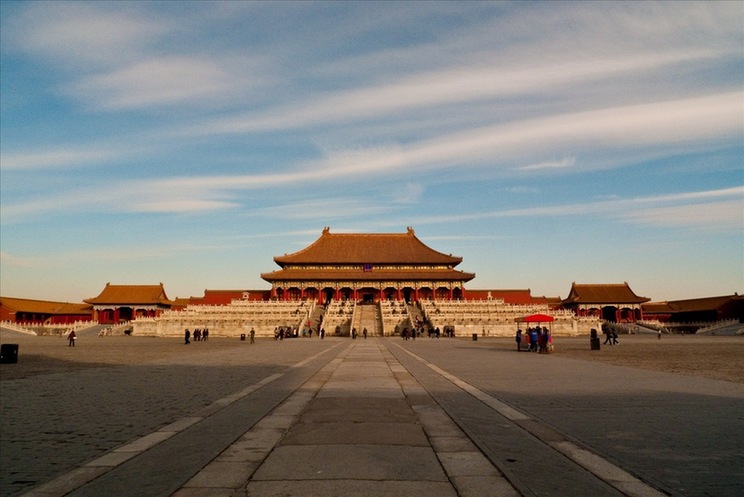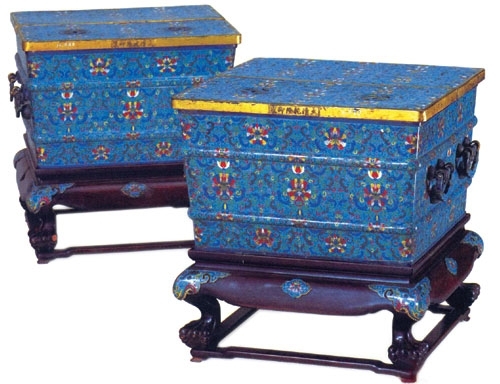当前位置: Language Tips> 双语新闻
Nowadays, air conditioning and electric fans help people beat the summer heat. But in ancient times, without such appliances, how did people find relief? Some cultural items collected at the Palace Museum in Beijing can help us figure out how Qing Dynasty (1644-1911) royal families, who lived inside the Forbidden City, spent their summer days.
现代人用空调、电扇等消暑,但古时候没有这些,人们又是如何抵挡暑热的呢?这期乐学我们就借北京故宫博物院里的若干文物,讲一讲清朝时紫禁城里的消夏良方。

【清宫消夏之"吃"】
Summer food and drinks in the royal court were mainly various kinds of melons and fruits, as well as tribute tea from around the country. When the emperors met officials, read books or memorials, they drank green tea, scented tea or milk tea. These drinks are refreshing and offer respite from the summer heat.
皇家在夏季的主要食物和饮品是各色瓜果,以及各地进奉的上等好茶。皇帝接见群臣或理政读书时,或饮绿茶、或饮花茶、或饮奶子茶,既提神,又解暑。
Iceboxes made of wood were widely used in the Qing royal court. Due to the weak conductivity of heat, lead or tin was put inside the box to extend the hours for preserving the natural ice. Many historical materials record emperors, empresses and imperial concubines using such a box to keep food like melons and fruits cool on hot summer days.
清代宫廷已经普遍使用木制"冰箱",其采用导热性较弱的铅或锡为里,以延长天然冰的使用时间。史书多有记载,清朝的皇帝皇后及后妃用"冰箱"储存瓜果,让其在炎炎夏日变得清凉可口。
[冰镇酸梅汤是慈禧最爱]
据慈禧的侄孙、曾于1900年随从护卫慈禧躲避八国联军逃到西安的叶赫那拉·岳超写于1962年的回忆文章《庚子辛丑随銮纪实》说:"辛丑在陕度夏,慈禧要吃冰镇酸梅汤,关中天气温热,向无存冰,御膳房计无所出。"所以当地人建议,到太白山里的岩洞取千年不化之冰,供御膳房使用。

图为清宫旧藏掐丝珐琅冰箱
【清宫消夏之"穿"】
Clothing for Qing Dynasty emperors was complicated and can be categorized according to different purposes, such as ritual clothes, auspicious clothes, traveling clothes and rain suits. And according to season, there were winter clothes and summer clothes.
清代皇帝的服装极为繁复,根据穿着用途有礼服、吉服、常服、行服和雨服等之分。根据季节则有冬夏之分。
Summer costumes for the royals were mainly made of fabrics like yarn and silk. The materials are permeable, which keep the wearer cool.
皇室成员夏季服装的面料以纱和绢为主,穿上透气性好,凉爽宜人。
[皇家衣橱一年才两换]
按照清代宫廷制度,季节变化时皇帝、后妃和王公百官们会统一更换服装。春、秋两季换装于每年三月和九月进行。通常礼部会从这两个月中的初五、十五、二十五三天内择吉日,并提前一个月上报,经御批,再由宫中传发公文到各衙门,统一按季更服,可使朝中服装整肃,避免混乱。
【清宫消夏之"住"】
Many features of the architecture in the Forbidden City helped relieve summer heat. The Zhizhai window, or hung and removable window, was a great invention. The upper part can be pulled up for ventilation, while the lower part can be removed to allow more light in.
为了避暑,紫禁城建筑上采取的降温措施很多,如宫殿的支摘窗就是一种很不错的发明,它上部可以支起通风,下部可以摘下透光。
The royal family could even enjoy an air-conditioned room in ancient times. As the iceboxes often had air holes, it could be used to cool the temperature of the room.
此外,清朝皇室已经开始享用"空调屋"——就是在"冰箱"上钻孔,让室温下降。
[乾隆修花园颐养天年]
乾隆三十七年(1772年),乾隆皇帝为自己退位后当太上皇享用而专修了一个花园,占地6400平方米,前后五进院落檐宇相连,建筑形式多样,装修极为考究。它位于紫禁城东北部,现"珍宝馆"内。花园内亭台殿阁错落有致,山石林木点缀其间,自然质朴,清新雅逸。在古华轩下小憩听风,倦怠定会一扫而光。
【清宫消夏之"用"】
The fan was another necessity for royals on summer days. Fans at the royal court varied widely. Exquisitely made, they were more than a tool for cooling people down; they were extraordinary works of art.
皇家还有一种消暑神器不得不提,那就是扇子。清代宫廷中的扇子,多种多样,用料上乘讲究,除了带给人们清风徐来的实际功用,俨然已是艺术品。
[雍正亲下旨指导做风扇]
雍正皇帝是个工作狂,同时还一心向佛生活俭朴,但也许是雍正比较怕热,他在制作风扇这个问题上一再和内务府交换意见,对它们的形状、质地、颜色、配饰以及摆放位置都有具体的要求。"尔等做的风扇甚好。朕想人在屋内推扇,天气暑热,气味不好。不如将后檐墙拆开,绳子从床下透出墙外转动,做一架。……再做一架放在西暖阁门北边,绳子从隔断门内透出。钦此。"

图为《孝慎成皇后观莲图轴》
Vocabulary
yarn: 纱(n.)
permeable: 可渗透的(adj.)
auspicious: 吉利的(adj.)
(中国日报双语手机报 彭娜)
上一篇 : 英邮筒安装电子标签防盗
下一篇 : 买不买?更衣室自拍求意见
电话:8610-84883645
传真:8610-84883500
Email: languagetips@chinadaily.com.cn